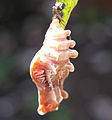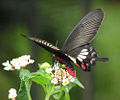সাধাৰণ গোলাপী পখিলা
| সাধাৰণ গোলাপী পখিলা (Common Rose) | |
|---|---|

| |
| Ventral View | |

| |
| Dorsal View | |
| জীৱবৈজ্ঞানিক শ্ৰেণীবিভাজন | |
| ৰাজ্য: | Animalia |
| পৰ্ব: | Arthropoda |
| শ্ৰেণী: | Insecta |
| বৰ্গ: | Lepidoptera |
| পৰিয়াল: | Papilionidae |
| গণ: | Pachliopta |
| প্ৰজাতি: | P. aristolochiae |
| বৈজ্ঞানিক নাম | |
| Pachliopta aristolochiae[1] (Fabricius, 1775)[1] | |
| সমাৰ্থক | |
|
Atrophaneura aristolochiae | |
সাধাৰণ গোলাপী পখিলা (ইংৰাজী: Common Rose, বৈজ্ঞানিক নাম-Pachliopta aristolochiae), Pachlioptaগণৰ অন্তৰ্ভুক্ত এটা চাতকনেজীয়া পখিলা (Swallowtail butterfly)ৰ প্ৰজাতি৷ দক্ষিণ আৰু দক্ষিণ-পূব এছিয়াত ই বহুলভাৱে বিস্তৃত হৈ আছে৷
বিৱৰণ
[সম্পাদনা কৰক]মতা সাধাৰণ গোলাপী পখিলাৰ পাখিৰ ওপৰৰ অংশ বেঙুনীয়া ক'লা বৰণীয়া হয়৷ আগফালৰ পাখি (Forewing)ত দীঘলীয়া বগা আঁচ ( adnervular streaks) কিছুমান থাকে৷ কিন্তু এই আঁচবোৰে কাষ দুটা স্পৰ্শ নকৰেহি৷ ইয়াৰ পিছফালৰ পাখিত কাষ দুটাৰ ওচৰত ৰঙা ঘূৰণীয়া ফোঁট থাকে৷ তাৰ ওপৰলৈ পাখিৰ মাজ অংশত দীঘলীয়া বগা ফোঁট (discal markings) কিছুমানো দেখা যায়৷

মাইকী সাধাৰণ গোলাপী পখিলা দেখাত মতা পখিলাটোৰ দৰেই, কেৱল ইয়াৰ পাখি দুখন মতাটোতকৈ কিছু বেছি বহল হয়৷
টেক্স'নমি
[সম্পাদনা কৰক]সাধাৰণ গোলাপী পখিলাৰ বৰ্তমানলৈকে ২০ বিধ উপ-প্ৰজাতি চিনাক্ত কৰা হৈছে৷ ইয়াৰে উল্লেখযোগ্য উপ-প্ৰজাতি কিছুমান হ'ল-[2]
- A. (P.) aristolochiae aristolochiae Fabricius.ভাৰত
- A. (P.) aristolochiae sawi Evans. নিকোবৰ দ্বীপপুঞ্জ
- A. (P.) aristolochiae camorta Moore. নিকোবৰ দ্বীপপুঞ্জ
- A. (P.) aristolochiae goniopeltis Walter Rothschild. আন্দামান দ্বীপপুঞ্জ, ম্যানমাৰ
- A. (P.) aristolochiae kondulana Evans. নিকোবৰ দ্বীপপুঞ্জ
বিতৰণ
[সম্পাদনা কৰক]সাধাৰণ গোলাপী পখিলা সমগ্ৰ এছিয়া মহাদেশতে বহুলভাৱে বিস্তৃত হৈ আছে৷ প্ৰধানকৈ আফগানিস্তান, পাকিস্তান, ভাৰত, নেপাল, শ্ৰীলংকা, ম্যানমাৰ, থাইলেণ্ড, জাপান, লাওছ, ভিয়েটনাম, নিকোবৰ দ্বীপপুঞ্জ, মালয়েছিয়া, ফিলিপাইনছ, ইণ্ডোনেছিয়া আৰু টাইৱান আদিত ইয়াক দেখিবলৈ পোৱা যায়৷
বাসস্থান
[সম্পাদনা কৰক]সাধাৰণ গোলাপী পখিলা বিভিন্ন ধৰণৰ বাসস্থানত থাকিবৰ বাবে অভিযোজিত ৷ দাক্ষিণাত্যত ইয়াক সাগৰ পৃষ্ঠৰ পৰা ৮০০০ ফুট পৰ্যন্ত আৰু পূবৰ হিমালয়ত ৫০০০ ফুট পৰ্যন্ত দেখা পোৱা গৈছে৷ নগৰীয়া অঞ্চলৰ বাগিচা আদিতো ইয়াক প্ৰায়ে দেখা যায়৷
আচৰণ
[সম্পাদনা কৰক]It is the commonest of the large tailed butterflies of India and one of the most interesting butterflies for the Indian amateur naturalist to observe.The Common Rose is active much earlier in the mornings than most butterflies and remains so throughout the day until dusk. It flies just as readily in the shade as in the sun, and frequently visits flowers.
অনুকৰণধৰ্মিতা
[সম্পাদনা কৰক]The red body, slow peculiar flight, bright colouration and pattern of the wings are meant to indicate to predators that this butterfly is inedible, being well protected by the poisons it has sequestered from its larval food plant. It also emits a nasty smelling substance when handled to further enhance its unappealing qualities. Hence it is rarely attacked by predators, a strategy so successful, that edible butterflies have evolved to mimic it, the classical example being that of the female morph of the Common Mormon that is Papilio polytes, female form stichius.
খাদ্য
[সম্পাদনা কৰক]The Common Rose frequently visits flowers such as Lantana, Cosmos, Zinnia, Jatropha and Clerodendron. The butterfly occasionally also visits wet patches. In parts of Sri Lanka, the males are known to congregate and form a beautiful sight while mud-puddling.
জীৱনচক্ৰ
[সম্পাদনা কৰক]কণী
[সম্পাদনা কৰক]The female has been observed inspecting Aristolochiae plants and selecting healthy plants with verdant growth to ensure adequacy of food for its voracious caterpillars. It lays round and reddish eggs with fine black markings. The eggs are laid singly on top, the underside of leaves or even on shoots.
পলু
[সম্পাদনা কৰক]

The caterpillar is a beautiful velvety maroon colour and has a beautiful white band on a segment on its middle reminiscent of a belt or collar. It has numerous fleshy red-tipped white protuberances on the body. It is bulky and slow in its movements. It is a beautiful caterpillar.
লেটা
[সম্পাদনা কৰক]
The pupa is brownish with various shades of brown and pink markings.
পলুৰ খাদ্য
[সম্পাদনা কৰক]The larvae feed on creepers and climbers of the genus Aristolochia, Family Aristolochiaceae and they sequester toxins such as aristolochic acid in their bodies. This makes the adults toxic to vertebrate predators such as birds and reptiles.[3] Larval foodplants include:
- Aristolochia bracteolata
- Aristolochia indica
- Aristolochia tagala
- Aristolochiae griffithi
- Thottea siliquosa
আলোকচিত্ৰৰ ভঁৰাল
[সম্পাদনা কৰক]-
Museum specimen, male, dorsal side
-
Museum specimen, female, ventral side
-
Similar species
-
Caterpillar
-
Caterpillar
-
Caterpillar about to pupate
-
Caterpillar in Hyderabad, India
-
Pupa
-
Freshly emerged adult
-
Common Rose Adult
-
on a Kadi Patta Murraya koenigii tree at Jayanti in Buxa Tiger Reserve in Jalpaiguri district of West Bengal, India
তথ্যসূত্ৰ
[সম্পাদনা কৰক]- ↑ 1.0 1.1 Häuser, Christoph L.; de Jong, Rienk ; Lamas, Gerardo ; Robbins, Robert K.; Smith, Campbell & Vane-Wright, Richard I. (28 July 2005). "Papilionidae – revised GloBIS/GART species checklist (2nd draft)". Entomological Data Information System. Staatliches Museum für Naturkunde Stuttgart, Germany. Archived from the original on 9 September 2010. https://web.archive.org/web/20100909141739/http://www.insects-online.de/frames/papilio.htm। আহৰণ কৰা হৈছে: 21 June 2013.
- ↑ Cotton, Adam; Fric, Zdenek Faltynek; Smith, Colin & Smetacek, Peter (March 2013). "Subspecies catalogue of the butterflies of India (Papilionidae): A Synopsis". Bionotes খণ্ড 15 (1): 5-8.
- ↑ Tian-Shung Wu, Yann-Lii Leu and Yu-Yi Chan (2000) Aristolochic Acids as a Defensive Substance for the Aristolochiaceous Plant-Feeding Swallowtail Butterfly, Pachliopta aristolochiae interpositus Journal of the Chinese Chemical Society 47:221-226 [1] Archived 2022-07-14 at the Wayback Machine
- Collins, N.M. & Morris, M.G. (1985) Threatened Swallowtail Butterflies of the World. IUCN. ISBN 2-88032-603-6
- Evans, W.H. (1932) The Identification of Indian Butterflies. (2nd Ed), Bombay Natural History Society, Mumbai, India
- Gaonkar, Harish (1996) Butterflies of the Western Ghats, India (including Sri Lanka) - A Biodiversity Assessment of a threatened mountain system. Journal of the Bombay Natural History Society.
- Gay, Thomas; Kehimkar, Isaac & Punetha, J.C.(1992) Common Butterflies of India. WWF-India and Oxford University Press, Mumbai, India.
- Kunte, Krushnamegh (2005) Butterflies of Peninsular India. Universities Press.
- Munshi, G. H.; & Moiz, S. A., 1967 Host plant specificity of the black swallowtail butterfly, Polydorus aristolochiae (Papilionidae) Journal of the Lepidopterists' Society 21: 127-128 pdf[সংযোগবিহীন উৎস]
- Munshi, G. H.; & Moiz, S. A., 1968 The pupa of Polydorus aristolochiae (Papilionidae) Journal of the Lepidopterists' Society 22:115-118 pdf
- Munshi, G. H.; & Moiz, S. A., 1968 Some observations on and description of Polydorus aristolochiae (Papilionidae). Journal of the Lepidopterists' Society 22(3):183-185, 2 tbls pdf[সংযোগবিহীন উৎস]
- Munshi, G. H.; & Moiz, S. A., 1969 Detailed description of larva of Polydorus aristolochiae Journal of the Lepidopterists' Society 23: 107-109 pdf[সংযোগবিহীন উৎস]
- Munshi, G. H.; & Moiz, S. A., 1970 Studies on the biology and seasonal history of Polydorus aristolochiae (Papilionidae). Journal of the Lepidopterists' Society: 19-22, 4 tbls pdf[সংযোগবিহীন উৎস]
- Wynter-Blyth, M.A. (1957) Butterflies of the Indian Region, Bombay Natural History Society, Mumbai, India.
বাহ্যিক সংযোগ
[সম্পাদনা কৰক]| ৱিকিমিডিয়া কমন্সত সাধাৰণ গোলাপী পখিলা সম্পৰ্কীয় মিডিয়া ফাইল আছে। |
| ৱিকিপ্ৰজাতিত সাধাৰণ গোলাপী পখিলা সম্পৰ্কে অধিক তথ্য আছে |















